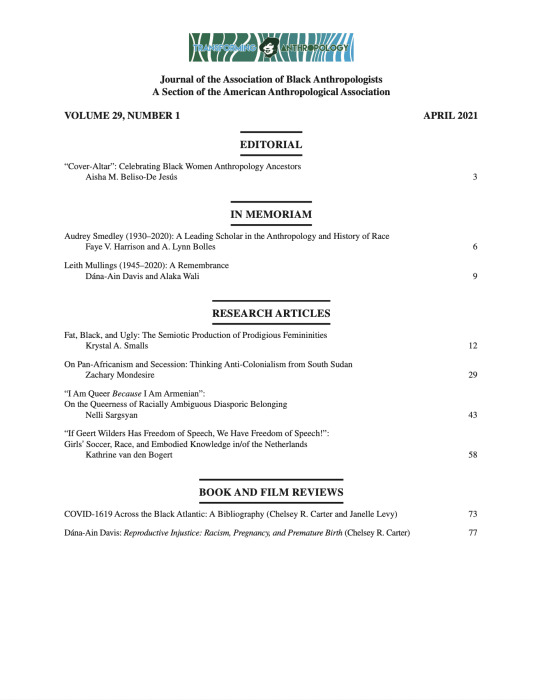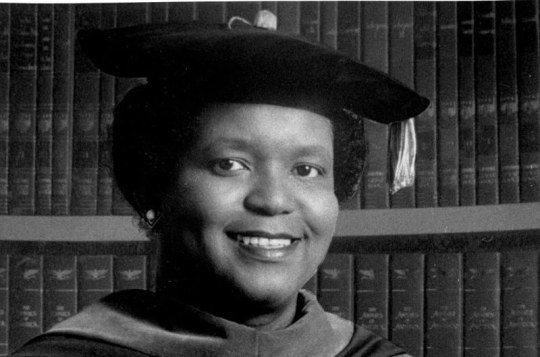#Niara Sudarkasa
Text


A recent number of Transforming Anthropology features portraits of black female anthropologists. These are renderings of well-known photographs, several of which have been featured here before.
#Transforming Anthropology (journal)#Leith Mullings#Audrey Smedley#Caroline Bond Day#Zora Neale Hurston#Vera Mae Green#Ellen Irene Diggs#Katherine Dunham#Diane K. Lewis#Angela Gilliam#Niara Sudarkasa
4 notes
·
View notes
Quote
According to Murdock, extended families are most appropriately described as two or more nuclear families linked through the parent-child relationship. Based on my study of the literature on traditional African extended families and upon my own fieldwork among the Yoruba living in Nigeria and in Ghana, it seems clear that many aspects of extended family organization are distorted by looking upon these groups as collections of nuclear families. Two salient features of African extended families should be noted. First, they were (and are,) to use Ralph Linton's terminology (The Study of Man, Appleton-Century, 1936), built around a consanguineal core (i.e. "blood relatives") rather than around a conjugal core (i.e. a married couple) as are nuclear families. Secondly, even though extended families can be subdivided into constituent units comprising a male, his wife or wives, and children, it is erroneous to conceive and describe a polygamous family as comprised of distinct nuclear families with a husband/father "in common". In other words, a group comprised of a man, his three wives, and children, should not be construed to be three nuclear families with a husband/father in common. Before the advent of Europeans in Africa, and in most places even today, a man and his several wives are considered to be a single family, and all the women and children therein are united by ties of obligation and affection to one another as well as to the husband/father. In fact, traditionally it was only for specified occasions, such as those involving the division of certain types of property, that there was a division made between the children of the different wives. Even then, however, such divisions were not conceptualized as distinct families.
Niara Sudarkasa - Exposition on the Value Premises Underlying Black Family Studies [JOURNAL OF THE NATIONAL MEDICAL ASSOCIATION, Vol. 67, No. 3, MAY 1975]
2 notes
·
View notes
Photo

Niara Sudarkasa (August 14, 1938 – May 31, 2019) was a scholar, educator, Africanist, and anthropologist who holds thirteen honorary degrees and is the recipient of nearly 100 civic and professional awards. Essence magazine named her "Educator for the '90s", and she became the first African American to be installed as a Chief in the historic Ife Kingdom of the Yoruba of Nigeria. She graduated from high school and accepted early admission to Fisk University on a Ford Foundation scholarship when she was 15 years old. She left Fisk and transferred to Oberlin College, where she earned a BA. She received her MS in anthropology from Columbia University. She taught at Columbia University, becoming the first African-American woman to teach there when she earned her Ph.D. She was appointed assistant professor of anthropology at New York University, the first African American woman to hold that position. She was the first African American to be appointed to the Department of Anthropology at the University of Michigan. She became involved in civil rights and student issues. She became the first female to serve as president of Lincoln University. During her presidency at Lincoln University, the school increased enrollment, strengthened its undergraduate and international programs, and put into place an ambitious minority recruitment effort. #africanhistory365 #africanexcellence https://www.instagram.com/p/ChPP3G4Oeg3pY5ZqBG-ystludTBkicJy_XXxZA0/?igshid=NGJjMDIxMWI=
0 notes
Text
#WCW: Niara Sudarkasa

Above photo: Infographic depicting the information about Niara Sudarkasa written in this post.
Niara Sudarkasa, OC Class of 1957
Sudarkasa was born Gloria Albertha Marshal in 1938 in Fort Lauderdale, Florida. She was an accomplished scholar, anthropologist, educator, and Africanist.
Born August 14, 1938; Died May 31, 2019
A.B., Oberlin College, 1957; M.A., Columbia University, 1961; Ph.D., Columbia University, 1964
"Niara" is derived from the Swahili word "Nia", which translates to "high purpose"
Named "Educator for the '90s” by Essence magazine
Author of numerous publications, including Exploring the African American Experience & Where Women Work: Yoruba Traders in the Marketplace and in the Home
Recipient of 13 honorary degrees and almost 100 civic and professional awards
MAJOR MILESTONES
1969- First African American appointed to Department of Anthropology at University of Michigan
1986- First female president of Lincoln University
2001- First African American installed as a Chief in the Ife Kingdom of the Yoruba of Nigeria
#OCLwomeninleadership#wcw#Oberlin College#Oberlin College Alumni#Obies#women in leadership#Niara Sudarkasa#OCLWomanoftheWeek
9 notes
·
View notes
Link
In “pre-colonial times,” wrote the late feminist scholar Niara Sudarkasa, women in West Africa were “conspicuous in high places.” They led armies, often played important consultative roles in politics, and in the case of the Lovedu people (present-day South Africa), they were even supreme Rain Queens. What it meant to be a woman in many African pre-colonial societies was not rigid. “Among the Langi of northern Uganda,” writes Sylvia Tamale, dean of the faculty of Law at Makerere University Uganda, “the mudoko dako, or effeminate males, were treated as women and could marry men.”
....
This practice of same-sex marriage was documented in more than 40 precolonial African societies: a woman could marry one or more women if she could secure the bridewealth necessary or was expected to uphold and augment kinship ties. The idea that a female could be a husband perplexed Europeans, and often lead to fantastical conclusions.
1K notes
·
View notes
Photo

Niara Sudarkasa, Brian Lanker, 1987-1988, Harvard Art Museums: Photographs
Harvard Art Museums/Fogg Museum, Schneider/Erdman Printer's Proof Collection, partial gift, and partial purchase through the Margaret Fisher Fund © Brian Lanker
Size: 37.2 x 37.2 cm (14 5/8 x 14 5/8 in.) sheet: 50.8 x 40.6 cm (20 x 16 in.)
Medium: Gelatin silver print
https://www.harvardartmuseums.org/collections/object/337835
1 note
·
View note